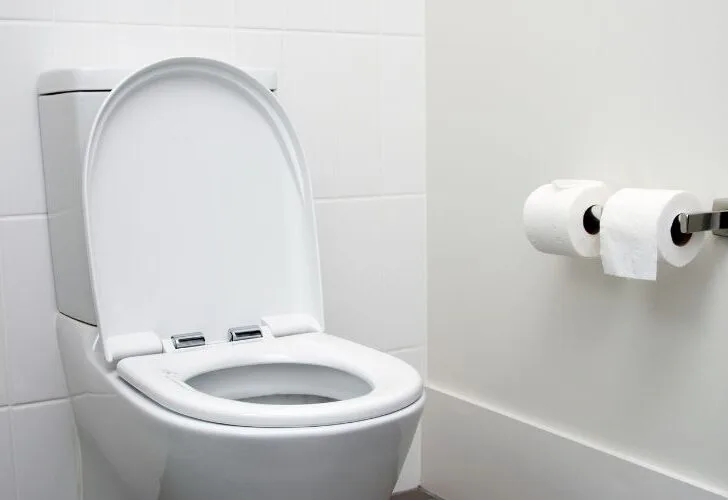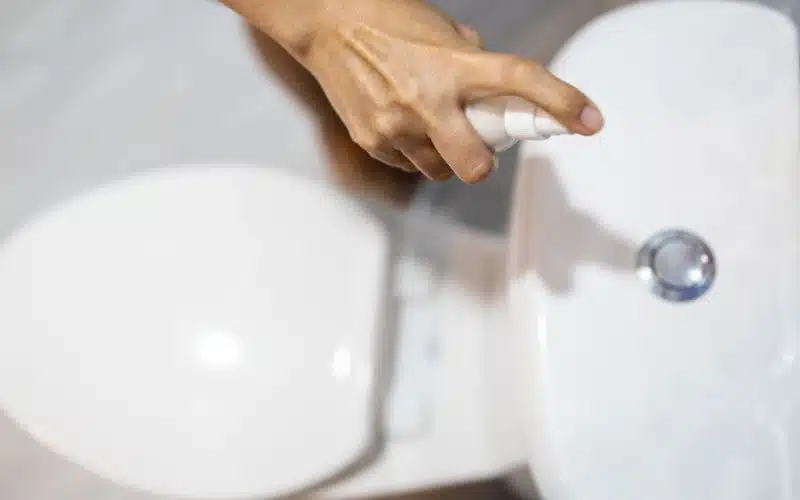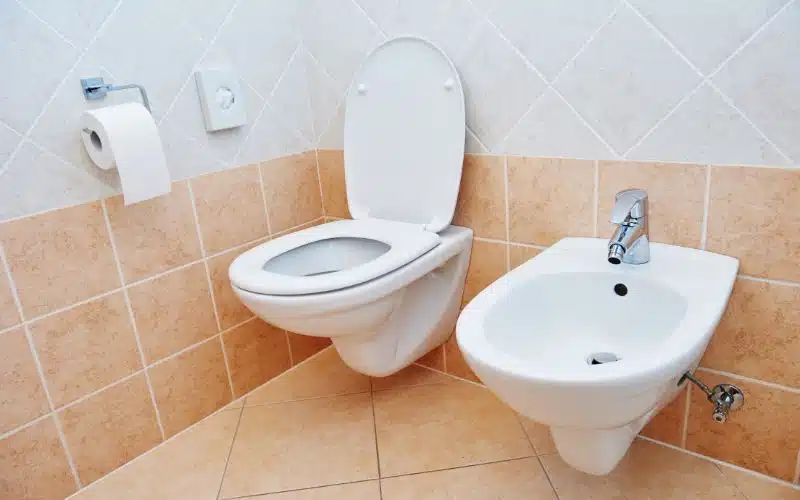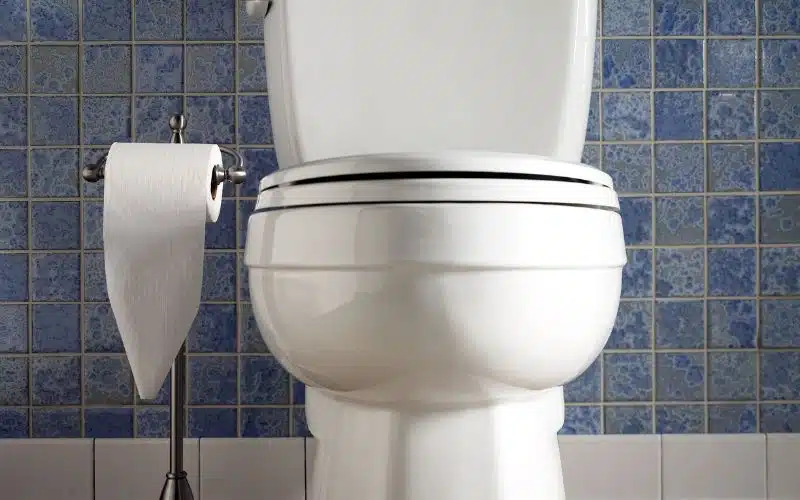Are you wondering if you’re doing the right thing by pinning your toilet seat to the wall? Do you think some consequences can occur if you don’t give sufficient space between the toilet seat and the wall?
Well, read through the guide and see the answers I have for you concerning those thoughts.
No law says toilet seats must be on the wall or stand inches away from the wall. However, your type of toilet seat model can decide what position is best for the toilet seat. The decision to keep your seat close to the wall or far from it is solely yours.
Can Toilets Rest Against the Wall?

Your toilet seats can rest against the wall if you prefer it to be that way. However, some toilet seat models will not give you the privilege of resting your seats on the wall.
Another factor that can affect that is if your building has a regulation guarding the toilet seat’s position.
Several buildings have pipelines and wirings inside walls, so keeping your toilet seat close to the wall may pose some risks.
For example, the constant push of the toilet on the wall may leave a crack that could break off a large portion over time.
Also, the best toilet setup is such that your toilet seat stays away from the tissue holder, bathtub, sink, and door. Any distortion in that arrangement would create an unnecessary inconvenience.
I’ll use this table to differentiate the experience of having your toilet close to the wall or keeping it away from the wall.
How Far Away Should a Toilet Be From the Wall?
The average distance of a toilet from the wall should be 12 inches from the back and 15 inches from the sides.
Any distance exceeding those numbers could reduce the size of your bathroom space. Too much distance between your toilet and the wall has no benefit whatsoever.
How would you feel if the bathroom door hit the toilet every time you opened or closed it? Maintaining minimum space between the toilet and the wall is important so you can easily grab stuff like tissue paper.
However, in whatever space you leave between the toilet and the wall, ensure these factors are in check.
- The toilet should be away from the sink.
- The toilet must have a little distance from the tissue paper.
- The bathroom door shouldn’t hit the toilet when you open and close it.
- There should be enough space for you to move around freely in the bathroom.
Should a Toilet Cistern Be Screwed To the Wall?
Most often, you’ll find yourself overthinking and wondering if you must screw your toilet cistern to the wall or not.
However, that shouldn’t be a cause of concern and worry because it simply doesn’t matter. The most important thing is to ensure that the base of your toilet seat is firm to the floor.
That’s because if the base of your toilet seat has improper positioning, it’ll wobble whenever you sit on it.
And, if your toilet seat wobbles, it’ll rock back and forth whenever you sit on it, creating discomfort.
Also, the toilet cistern model can influence this factor to determine whether you must screw it to the wall.
If you have the old cistern that requires flushing with a downward turn on a handle, you’ll need to screw it to the wall.
However, the modern toilet cistern with a knob on which you’ll press to flush doesn’t require screwing.
Ensure that the base of the toilet seat sits firmly on the ground to avoid back and forth rocking.
Also, buying a toilet seat with a cistern without holes for screwing to the wall is possible. In such an instance, you’ll have to keep the cistern from the wall.
However, you can consider an alternative if you feel uncomfortable sitting on a toilet seat with a free cistern.
In any case, if you aren’t sure about how to position your toilet seat, get a professional to help you.
Can a Toilet Be Too Far From the Wall?
If you choose not to pin your toilet seat to the wall, you must follow the standard distance to be on the safe side.
I’d recommend the bathroom wall should be 12 inches from the back of the toilet seat and 15 inches from the sides. So, anything above these measurements will pose discomfort for you.
Often, toilet seats get too far from the wall due to wrong measurements during installation. If you keep our toilet too far from the wall, your bathroom space will become smaller.
You’ll also find it difficult to reach the toilet paper and open your bathroom door without hitting the toilet.
The good thing is that there’s a way out of having your toilet seat too far from the wall. You’ll have to move the toilet closer to the wall.
However, you’ll need to buy an offset flange because it gives freedom to move a toilet seat several inches in any direction.
An offset flange would connect your toilet seat to the pipes, ensuring that the toilet moves closer to the wall.
Hence, moving your toilet seat closer to the wall will be difficult without a flange. However, that process is doable if you pay close attention to the details, but if you can’t, get the help of a professional.
What To Do If Toilet Is Too Far From Wall
Toilet seats can have wrong measurements and sit too far from the bathroom wall. If that’s the situation with your toilet seat, I can help you with how to push it closer to the wall.
#1. Getting an Offset Flange
You’ll need a flange to reposition your toilet seat closer to the wall. What a flange does is connect your toilet seat to the pipes.
All you’ll need to do with the flange is to bolt it underneath the toilet seat while connecting it to the pipes.
You’ll need to purchase the correct flange size as there are varying sizes of flanges in the market.
However, a flange that has a tuba shape with a wider opening at the top than the bottom would be ideal.
You’ll need to secure a rubber gasket between the offset flange and the toilet seat. That’ll keep sewage gases from escaping into the air in the bathroom. It also prevents the toilet from leaking out.
#2. Secure the Space
The next thing you’ll do after getting a flange is to map out a space for your toilet seat in the bathroom.
Without having a space in mind, you’ll not know where to move the toilet seat to when the time comes.
So, to avoid such confusion, determine the right spot that will be perfect for your toilet seat before moving it.
Also, you’ll need to turn off the house’s water supply by switching off the water control knobs.
Also, place dry materials such as towels and newspapers on the ground to avoid water spillage while moving.
That’ll ensure that you have little work of mopping the bathroom floor at the end of the repositioning.
#3. Move the Toilet
Here, you’ll need a helping hand, especially when moving the toilet seat from the old position to the new one.
There are a few basic steps to achieve a new position for your toilet seat.
- Remove the toilet.
- Install a new offset flange.
- Reinstall your toilet seat in its new position closer to the wall.
If this step proves too hard for you, seek an expert’s help so you don’t damage your toilet seat.
Conclusion
The question of how far or near your toilet seat can be from the bathroom wall depends on personal preferences.
However, if you want the toilet seat away from the wall, ensure it doesn’t exceed 12 inches from the back.
Also, you can pin your toilet seat to the bathroom wall, but that’ll depend largely on the toilet model.





